Abstract
Gem-quality garnets, with their high closure temperature (750–800 °C), high transparency, uniform composition, and purity, offer promising prospects for U-Pb dating. Despite decades of recognition that garnets can be dated using the U-Pb method, direct dating remains extremely limited. Tsavorite is a rare gem-quality green vanadium-rich grossular hosted in the Neoproterozoic Metamorphic Mozambique Belt (NMMB). Until now, the accurate crystallization age of the tsavorite in Kenya and Lemshuku (Tanzania) has remained unknown. Here, we conducted in situ laser U-Pb geochronological analysis on gem-quality tsavorite samples from Tanzania and Kenya. U-Pb dating of tsavorite sourced from the Lemshuku mine (Tanzania) and the Tsavorite mine (Kenya) yielded ages of 643.9 ± 3.2 Ma and 617.4 ± 4.8 Ma, respectively. The high closure temperature of the U-Pb system within garnets renders it more inclined to preserve crystallization ages rather than documenting cooling events or metamorphic overprinting. Consequently, these ages are indicative of the tsavorite mineralization epochs. These findings align with the most significant metamorphic period documented in the Mozambique Belt, known as the East African Orogen, which occurred between 640 and 600 Ma. U-Pb data have revealed distinct formation times for each district. Dating specific deposits can provide more precise information about the origin of tsavorite, rather than solely relying on isotope or trace element data that have long been used for provenance studies of tsavorite.
1. Introduction
The Neoproterozoic Metamorphic Mozambique Belt (NMMB) is one of the most famous and important geological units since the definition of the Mozambique Belt in East Africa [1], which extends from the Arabian–Nubian Shield through East Africa, Madagascar, South India, and Sri Lanka to East Antarctica [2,3]. The NMMB, also referred to as the “Gemstone Belt of East Africa” or the “PanAfrican Gems and Graphite Belt”, harbors an abundance of significant gem deposits comprising ruby, sapphire, emerald, spessartine, tsavorite, tourmaline, spinel, tanzanite, and alexandrite [4,5,6]. Notably, some of these gemstones are exclusive to the NMMB, such as tsavorite, the gem-quality vanadium-rich green grossular [7]. As a gemstone of significant economic value, tsavorite is exclusively found in the metasedimentary formations of the NMMB. Except for a few mines in southern Madagascar [8] and sporadic exploitation in the Swat Valley in Pakistan [9], gem-quality tsavorite of economic value is exclusively mined in south-eastern Tanzania (Ruangwa and Tunduru), north-eastern Tanzania (Lelatema fold belt), and south-eastern Kenya from Mgama Ridge to Ngomet. Among them, the only tsavorite deposits with significant economic value and those that have undergone commercial exploitation are located in Kenya and Tanzania [10].
Understanding the mechanisms and timing of gemstone mineralization is crucial for the development of exploration strategies. Due to the unsuitability of gemstones for radiometric dating, researchers often estimate the age of gemstone deposits in the NMMB by dating other minerals in their host rocks [10,11,12]. Recent geochronological studies have constrained the timing of tsavorite crystallization at 605 ± 35 Ma in north-eastern Tanzania [13,14], and at 600–615 Ma in south-eastern Kenya [15] using different rocks, minerals, and isotope systems. Indirect dating hinges on the presumption that gem mineralization is coeval with the dated mineral. If this presumption proves incorrect, the resultant age may furnish information unrelated to the formation of gemstones. Gemstone dating typically relies on isotopic measurements conducted on samples from a relatively extensive geographical area to establish an isochron or on the dating of inclusions (such as rutile inclusions in ruby and sapphire), which are purported to offer “cooling” ages [16,17]. However, isochron dating can be problematic if the gemstones formed under slightly differing conditions or at different times, reducing the likelihood of the “age” possessing geological significance. Inclusion dating, even when cooling rates are considered well constrained, only allows for a qualitative estimation of the host gemstone’s “crystallization” age.
Over the past decade, there has been a growing recognition of the U-Pb system’s utility for in situ dating in garnet, as evidenced by various studies. The application of the U-Pb system to gem-quality garnet is particularly promising due to its high closure temperature, exceeding 750–800 °C [18,19]. This high temperature guarantees that the system within garnet captures crystallization ages specifically, distinguishing them from cooling or metamorphic ages. Recent research on demantoid (gem-quality andradite) from Russia has successfully demonstrated the potential of U-Pb dating in constraining demantoid mineralization [17]. Gem-quality andradite sourced from Turkey has been recognized as a viable candidate for a natural secondary reference material in U-Pb dating [20]. Similarly, the first application of U-Pb dating to tsavorite from Umba and Merelani in northern Tanzania was recently reported by Brendan C. et al. [21]. However, the age data of tsavorite are limited, and until now, the accurate crystallization age of the tsavorite in Kenya and Lemshuku (Tanzania) has remained unknown. The first direct in situ U-Pb LA-ICP-MS dating of gem-quality tsavorite was carried out on samples with low-U content obtained from Kenya. Our results show that the in situ U-Pb dating technique used for gem-quality tsavorite may have practical significance in gemology and geochronology science.
2. Geological Setting
The late Neoproterozoic Metamorphic Mozambique Belt (NMMB) of East Africa [1] comprises the southern segment of the East African Orogen [2], which stretches through Mozambique, Madagascar, Tanzania, and Kenya, and is composed of the Eastern and Western Granulites, the Irumide Belt, and the Nampula Block high-grade metamorphic rocks of different ages. In Tanzania, the Eastern Granulites are divided into a basal unit largely composed of metaigneous rock suites and an upper unit with metasedimentary rocks including marbles [22]. In the Taita Hills of southern Kenya, equivalent units are mapped as meta-magmatic Kasigau Group and metasedimentary Kurase Group [23,24,25]. The Eastern Granulite rocks, where tsavorite is found, originated in a marine coastal sabkha setting within the Mozambique Ocean, positioned between the Congo–Tanzania Craton and the Azania microcontinent [7]. It is now established that Gondwana’s polyphase amalgamation resulted in two distinct orogenic phases documented in the Mozambique Belt: “the East African Orogen” and “the Kuunga Orogen” [2,26,27]. “The East African Orogen” (Figure 1D) encompasses the Arabian–Nubian Shield, the northern microcontinent Azania, and the southern Mozambique Belt, and comprises Neoproterozoic-to-Cambrian metamorphic rocks ranging from upper amphibolite to granulite facies across eastern Africa, with peak granulite facies metamorphism occurring at ~640–600 Ma under conditions of 10–12 kbar and 800 °C [25]. The Kuunga Orogen (Figure 1D), oriented E-W, was formed by the thrusting of the East African Orogen rocks in the Namuno Terrane over the old Nampula Terrane at ca. 580 Ma [26].
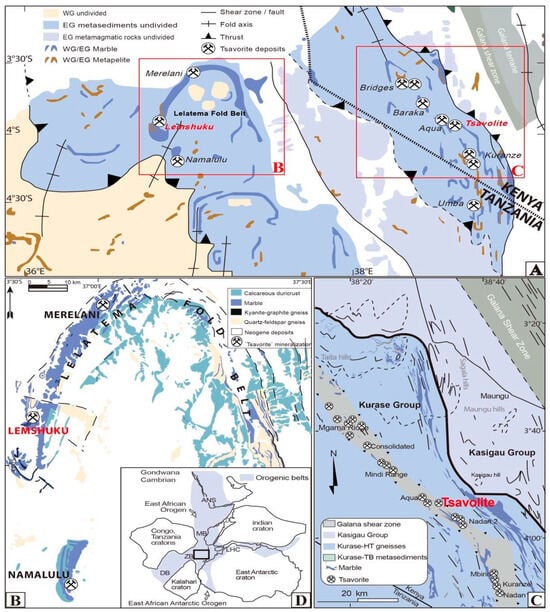
Figure 1.
(A) Geological sketch map of SE Kenya and NE Tanzania with the localities of tsavorite deposits. (B) Tectonic map of the Lelatema fold belt of Tanzania with the locality of the tsavorite deposits. (C) Simplified geological map and localization of tsavolite deposits in Kenya. (D) The East African Orogen and the Kuunga Orogen. EG—Eastern Granulites; WG—Western Granulites; ANS—Arabian–Nubian Shield; MB—Mozambique Belt; ZB—Zambesi belt; DB—Damara belt; and LHC—Lützow Holm Complex.
All these tsavorite deposits of economic value are located within the Eastern Granulites of the Mozambique Belt [11,28,29]. In north-eastern Tanzania and south-eastern Kenya (Figure 1A), in the Kurase Group [30], mines define a tight north–south trending stratiform corridor extending more than a hundred kilometers, forming the largest tsavorite-bearing belt worldwide [11]. The discovery of tsavorite in south-eastern Kenya dates back to the work of Bridges in 2007, with over fifty small deposits now being exploited in the Taita–Taveta and Kwale districts [31]. The primary mining areas include Mgama Ridge, Mindi Range, Mangare–Kisoli, and Kuranze, all hosting deposits within graphitic gneiss from the Kurase Group, occasionally accompanied by ultramafic rocks (Figure 1C). In Tanzania, four significant tsavorite mining districts are identified: Umba–Kalalani, the Lelatema fold belt, Ruangwa, and Tunduru in the south-east (Figure 1B). The Lemshuku mining district, situated in the western section of the Lelatema fold belt and positioned 15 km east of Komolo, was first surveyed by Bridges in 1967. Here, tsavorite occurs within quartz veins, associated with quartz, calcite, pyrite, graphite, and occasionally tanzanite surrounding the garnet. The Lemshuku placer consists of pebbles and blocks of graphitic gneiss, quartzite, pegmatite, and quartz, ranging in size from a few centimeters to one meter. Tsavorite is also found alongside gem-quality kyanite, tourmaline, and rare ruby in this area [7]. We obtained tsavorite samples from the Lemshuku mine in Tanzania and the Tsavorite mine in Kenya (Figure 1A).
3. Materials and Methods
3.1. Sample Description
The tsavorite samples utilized in this study, comprising four from Tanzania (n = 4) and four from Kenya (n = 4) (Figure 2A), were meticulously chosen from rough stones (Figure 2B) sourced directly from the mine site and subsequently underwent precision cutting. The two primary deposits in this study are from the Lemshuku mine in the Lelatema fold belt and the Tsavolite mine in Kenya (Figure 1); the tsavorite samples were in contact with anhydrite, graphitic gneiss, and quartz (Figure 2C–E). All of the tsavorite samples are optically transparent and free of inclusions (Figure 2).
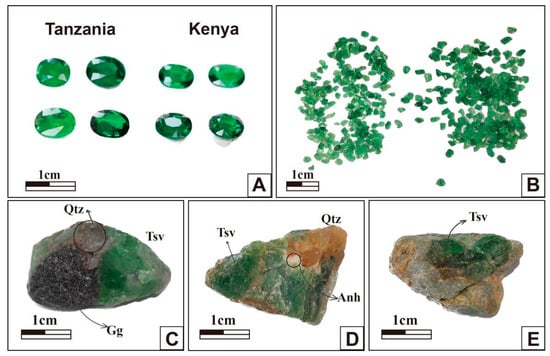
Figure 2.
(A) The tsavorite samples from the Lemshuku mine, Tanzania, and the Tsavorite mine, Kenya; (B) rough tsavorite stones; (C–E) minerals occurring with tsavorite. Qtz—quartz, Gg—graphitic gneiss, Tsv—tsavorite, and Anh—anhydrite.
3.2. Methods
The electron probe microanalysis was performed with test conditions of 15 kv accelerating voltage, 27–29 μA emission current, and a 5 μm beam spot diameter, utilizing EPMA-1720 (ID: 1210229S) from the Probe Laboratory of the China University of Geosciences (Beijing). Oxygen isotope analysis of tsavorites can determine their origin and is measured using the laser fluorination technique. The analytical system employs a Delta Plus XP mass spectrometer to analyze collected oxygen using stable gas isotope ratios. A dual-channel test was conducted, balancing pressure and ion beam intensity at 3 V. The test sequence was executed, followed by six dual-channel comparisons, each lasting 20 s. The system achieves an internal accuracy better than 0.06‰. The calibration standard sample is GBW04409 quartz (δ18OV-SMOW = +11.11) and the quality control sample is GBW04410 quartz (δ18OV-SMOW = −1.75). Data are reported in the conventional delta notation (δ18O, expressed in per mil (‰)) relative to the Vienna Standard Mean Ocean Water (V-SMOW) standard.
In situ microanalysis of minerals can contain a lot of information [32,33,34]. The trace element geochemistry and U-Pb isotope of tsavorite garnets were performed on an Analytikjena PlasmaQuant MS quadrupole ICP-MS with a 193 nm NWR193 Ar-F excimer laser at Yanduzhongshi Geological Analysis Laboratories Ltd, Beijing, China. MALI grandite (U-Pb TIMS = 202.0 ± 1.2 Ma) [35] was used as the primary standard to calibrate the U-Pb geochronology of garnets. Garnet standards Willsboro andradite (U-Pb TIMS = 1022 ± 16 Ma) [35] and Zsls-01 (in-house reference material; 155 ± 2 Ma) were employed as secondary quality control standards. Instrument drift, mass bias, and fractionation of the U-Pb ratio were corrected with a standard-sample bracketing method. The trace element concentrations of garnets were quantified using SRM 610 as the external standard and 29Si as the internal standard element assuming a stochiometric garnet composition.
Each analysis on the garnets began with a 15 s blank gas measurement followed by a further 40 s of analysis time when the laser was switched on. A flow of He carrier gas at a rate of 0.6 liters/minute carried particles ablated by the laser out of the chamber to be mixed with Ar gas and carried to the plasma torch. The raw data were corrected offline by employing ICPMSDataCal software [36,37] and ZSkits software [38]. Isoplot 4.15 was used to calculate U-Pb ages and obtain the lower intercept ages in the Tera–Wasserburg diagram, which can be used as the formation time of minerals with a mixture of radiogenic and initial common Pb [39]. For the Tera–Wasserburg Concordia intercept age, because of the similar 238U/206Pb, 207Pb/206Pb ratios, and low common Pb of the sample, the initial 207Pb/206Pb ratios of these samples were anchored based on the terrestrial Pb evolution model of Stacey and Kramers [40]. In fact, due to the low common Pb, intercept age difference according to different initial 207Pb/206Pb is typically less than 1%.
4. Results
4.1. Chemical Composition
The chemical compositions of tsavorite samples from Kenya and Tanzania are detailed in Table 1 and illustrated in Figure 3. EPMA analysis revealed that the samples consist of nearly pure grossular (87–93 mol.%), with the Kenyan tsavorite having a higher grossular content than the Tanzanian samples. Vanadium content determines the goldmanite proportion (1.7–7.9 mol.%), which is the second main component. Chromium, manganese, and magnesium directly influence the proportions of uvarovite (0.2–0.8 mol.%), spessartine (1.3–3 mol.%), and pyrope (1.3–2.5 mol.%). Iron end-member andradite (Fe3+) is low (0.03–0.37 mol.%). As shown in Figure 3, the chemical composition of our tsavorite samples is consistent with the chemical composition of Kenya and Tanzania samples in previous studies [41].

Table 1.
The chemical composition of tsavorite from Kenya and Tanzania analyzed by EMPA.
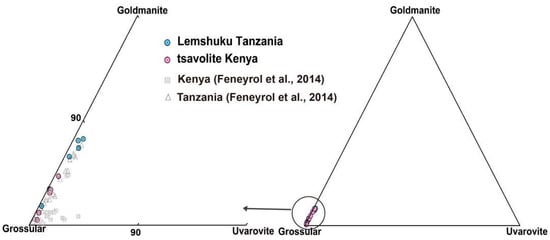
Figure 3.
Ternary diagram of the goldmanite–grossular–uvarovite contents of tsavorites from Kenya and Tanzania (Some datas from [41]).
4.2. Trace Element Geochemistry
Generally, trace element chemistry varies among tsavorites of different origins, with notable variability in V3+ and Cr3+ substituting Al3+ in garnet’s Y-site, and Mn2+ substituting Ca2+ in the X-site. Based on previous studies, Merelani is known for vanadium-poor tsavorites, whereas Lemshuku produces vanadium-rich ones in Tanzania [41]. In Kenya, the vanadium-poor tsavorites originate from Mwatate, while the most vanadium-rich samples correspond to the Tsavorite mine. Unlike vanadium content, Tanzanian and Kenyan tsavorites differ in Cr content. Tanzanian samples typically contain less than 1000 ppm of Cr, while Kenyan ones exceed this threshold in this study. The chromophore elements V and Cr in tsavorites analyzed in this study exhibit similar concentrations to those reported from other Tanzanian and Kenyan deposits (Figure 4A, Table 2). The V content is generally lower in tsavorite from Kenya compared to Lemshuku. The V/Cr ratios in tsavorite from Kenya and Lemshuku are ~4 and ~15, respectively. The Mn contents in tsavorite from these three sources also align with previously published data for each locality [41]. Interestingly, the U content is lowest in samples with the highest V concentrations and higher in tsavorite from Kenya and Namlalulu compared to Lemshuku (Figure 4B).
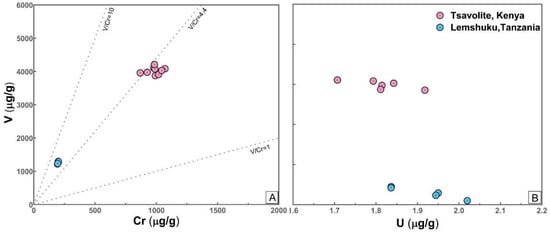
Figure 4.
(A) V and Cr plot of tsavorite from Tanzania and Kenya, with V/Cr reference lines from [33]. (B) V and U plot of tsavorite from Tanzania and Kenya.

Table 2.
Trace elements of samples from Tanzania and Kenya obtained by LA-ICP-MS.
Tsavorite from Kenya and Tanzania exhibits chondrite-normalized rare earth element (REE) patterns that are characteristic of garnet found in amphibolite and granulite facies metasedimentary rocks, as depicted in Figure 5. Both localities show depletion in LREE relative to HREE, with both exhibiting mild negative Eu anomalies. Tsavorite from Kenya displays slightly less depletion in LREE compared to that sourced from Tanzania’s Lemshuku mine. The aluminum-rich garnets of magmatic and metamorphic origin often exhibit characteristics of HREE enrichment and LREE depletion [42], which may be due to the preferential binding of HREE with calcium aluminum garnet [43].
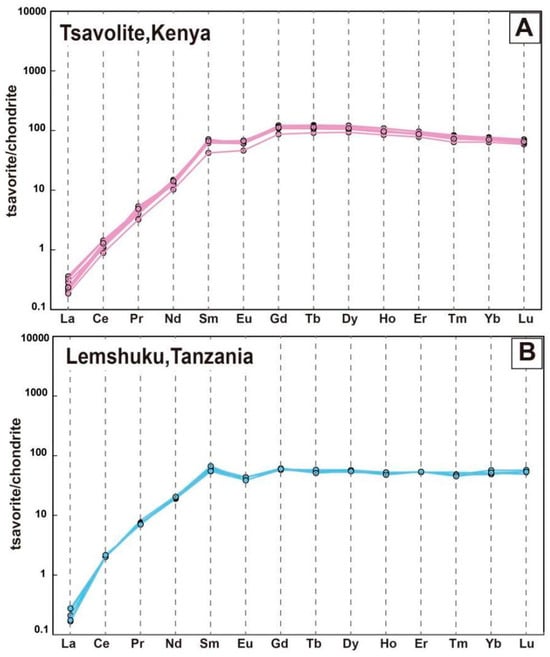
Figure 5.
Chondrite-normalized REE patterns of the different parts of tsavorites from Kenya (A) and Tanzania (B). The normalization values for chondrite were from [44].
4.3. Oxygen Isotope
A valuable tracer for deciphering the geological and/or geographical origins of emerald and corundum has been proven to be the variation in the oxygen isotope composition [45]. The δ18O value of tsavorite is a good indicator of the environment of its formation. This is due to the equilibrium between vanadium grossular garnet and δ18O in the fluid, which is buffered by the surrounding rock during metamorphism and water–rock reactions. The range of the δ18OV-SMOW of the tsavorite samples from Kenya and Tanzania is 14.11–14.44‰ and 16.45–16.86‰, respectively (Figure 6). Notably, the high δ18O signatures for tsavorite from Lemshuku suggest that the δ18O level of the metamorphic fluid in equilibrium with the mineral was buffered at high temperature by the high 18O/16O ratio of the marble-rich metasedimentary series. The δ18O values correspond to tsavorite from Kenya [45], which is consistent with our test data. Within these deposits, graphitic gneisses are the primary component, while the occurrence of marbles is either minimal or confined to calcareous nodules, seams, and lenses [17]. The tsavorite deposits from Kenya were not carbonate-dominated, which resulted in the δ18O of the fluid in equilibrium with tsavorite being buffered primarily by graphitic gneiss, which has a δ18O value lower than 15‰.
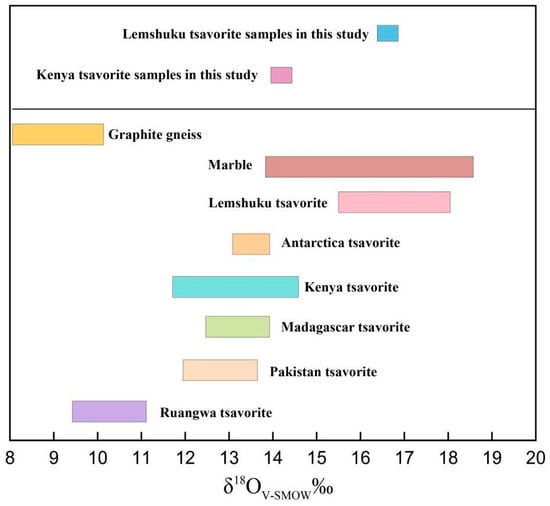
Figure 6.
The δ18O values of tsavorite samples in this study. The δ18O values of Ruangwa (Tanzania), Lemshuku (Tanzania), Kenya, Madagascar, Pakistan, and Antarctica tsavorites, with the corresponding data sourced from [45]. The δ18O values for graphite gneiss and marble were obtained from [46].
4.4. U-Pb Geochronology
The garnet mineral system poses a significant challenge for U-Pb geochronology, particularly due to almandine, pyrope, and spessartine-dominated garnets generally containing U and Th concentrations below ~100 ppm [46,47]. Zircon U-Pb geochronometry offers a precise timeline of magmatic activities, while grossular–andradite U-Pb dating could offer a parallel insight into hydrothermal systems [35]. The U-Pb isotope dating for the tsavorite samples is presented in Table 3. The lower intersection point age for tsavorite samples from Kenya and Lemshuku ages ranges from ~643.9 to ~617.4 Ma, as depicted in Figure 7A,B. The errors in our data are quoted at the 95% confidence level.

Table 3.
U-Pb isotope compositions of tsavorite from Tanzania and Kenya.
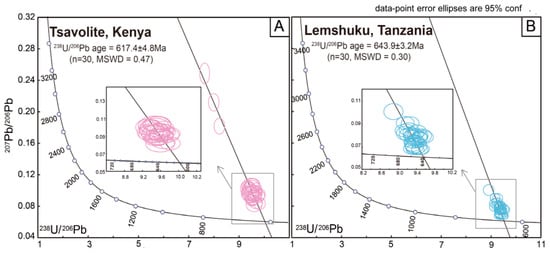
Figure 7.
(A) The lower intersection point age of tsavorite samples from Lemshuku, Tanzania. (B) The lower intersection point age of tsavorite samples from Kenya.
5. Discussion
5.1. Origin Identification
Nowadays, one of the primary challenges faced by gemological laboratories is tracing the provenance of gemstones [45], given that their value can be greatly influenced by their origin, with tsavorite being no exception. Additionally, it is imperative to verify the accuracy of a tsavorite sample’s origin prior to analyzing its chronology. Concentrations of V, Cr, and Mn are good chemical “fingerprints” for determining the geographic provenance of economic tsavorite from East Africa. These three elements serve as the principal trace elements in tsavorites and exhibit the most significant variations among different samples, contrasting with the relatively consistent concentrations of Mg, Ti, or Fe [41]. As shown in Figure 8, our tsavorite samples are classified as type 3 from Lemshuku in Tanzania and type 2 from Kenya, aligning with the classification by Feneyrol et al. [41].
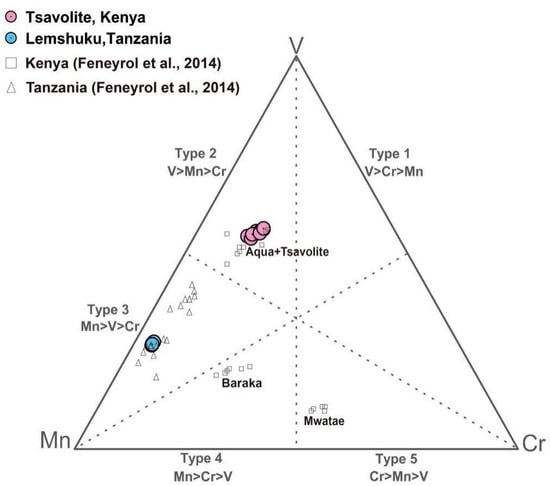
Figure 8.
The ternary V–Cr–Mn diagram illustrates the five distinct chemical types of tsavorite found globally, classified based on their trace element compositions (Some datas from [41]).
Additionally, the δ18O value of tsavorite serves as a reliable indicator of the conditions surrounding its formation. A comprehensive comparison that utilized the integration of oxygen isotope composition with trace element concentrations was conducted by Giuliani et al. between tsavorites sourced from the main deposits worldwide [45]. As a result, a comprehensive database was established, encompassing both isotopic and chemical compositions of tsavorite, which allows for the accurate identification of the geological and geographical origins of these precious gemstones. The oxygen isotope analysis of the tsavorite samples from Kenya and Tanzania in this study aligns with previously reported findings, further confirming the authenticity of the sample sources (Figure 9).
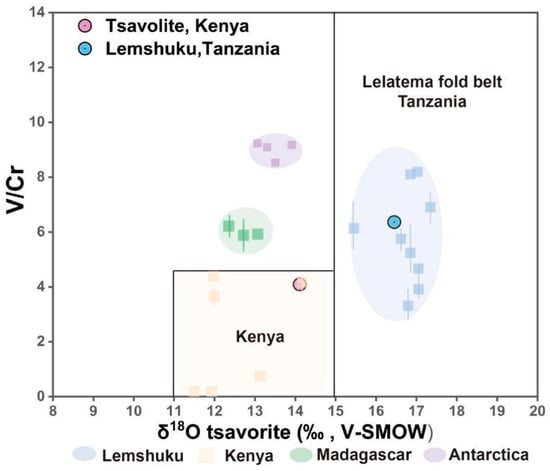
Figure 9.
The δ18O and V/Cr ratios of tsavorites sourced from the Neoproterozoic Mozambique Metamorphic Belt deposits (data from [45]).
5.2. Age Interpretations
At the Lelatema fold belt in Tanzania, the age of tsavorite mineralization was determined either by referencing the ages of the host rocks or through Sm/Nd dating of four tsavorite-bearing samples from quartz veins in Merelani, yielding an isochron age of 606 ± 36 Ma [14]. However, U-Pb ages are preferable because they eliminate the need to aggregate tsavorite samples from a broader region, avoiding assumptions of concurrent formation from identical fluids, and uncertainties between cooling and crystallization ages due to the higher inferred closure temperature of U-Pb in garnet compared to the Sm-Nd system. Studies on Pb diffusion in grossular garnet indicate a closure temperature reaching approximately 975 °C [47]. Considering that these temperatures surpass the peak metamorphic temperatures recorded in the area, which range from 610 to 720 °C [25], the U-Pb ages reported here directly reflect the crystallization of tsavorite.
The East African Orogen, spanning north-eastern Tanzania and south-eastern Kenya, is the result of interactions among various microplates during a specific timeframe (600–640 Ma) [23]. The U-Pb ages presented suggest that tsavorite mineralization took place during the East African Orogen (Figure 10). It is suggested by Brendan C et al. that tsavorite mineralization corresponds to the later Kuungan orogenic episode (570–530 Ma), based on the U-Pb dating results of tsavorite from Merelani and Umba, in the Lelatema fold belt, Tanzania [22]. Hence, it is possible for garnet to form multiple times during single or multiple metamorphic events. The earlier regional metamorphism aligns with the East African Orogen, whereas the most recent one may coincide with the final phase of the East African Orogen or the Kuunga Orogen.
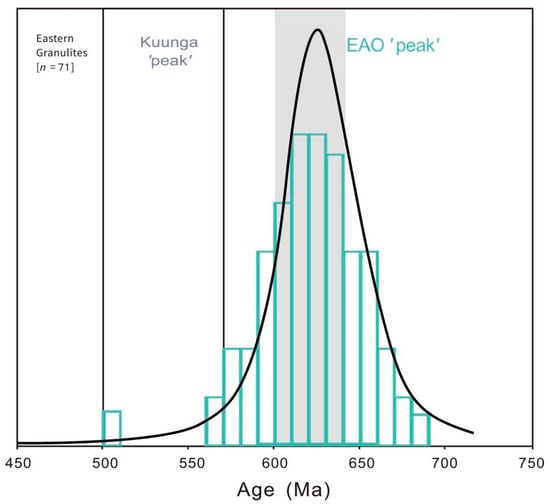
Figure 10.
Kernel density estimation of metamorphic mnz, ttn, and zrc (rims) from within the Eastern Granulites [7,13,14,26,48,49].
5.3. Age Implications
For a considerable period, the identification of tsavorite’s origin has primarily relied on trace elements, especially focusing on the concentration and proportion of color-inducing elements like chromium and vanadium [11,17]. This U-Pb dating study indicates that two tsavorite mining localities formed at different times, suggesting that dating specific deposits or mines could offer more precise information about tsavorite’s origin than just analyzing minor or trace elements. Furthermore, the application of U-Pb dating to tsavorites from Madagascar and Pakistan could pave the way for future research endeavors, aiding in the geographical origin determination of tsavorites. The application of U-Pb geochronology in determining the provenance of tsavorite gemstones offers a significant advantage in tracing their geological origins. Given the recent application of U-Pb dating to garnets with extremely low uranium content [18], utilizing reference materials with low uranium levels (~single-digit micrograms per gram or below) becomes highly beneficial, as it ensures consistency in counting mode between standards and unknowns on the mass spectrometer. Gem-quality tsavorite, characterized by its crystalline structure, high closure temperature (750–800 °C), high transparency, uniformity, and purity, holds promise as a reference material for U-Pb dating using LA-ICP-MS.
6. Conclusions
In this study, the first U-Pb dating test on tsavorites from Kenya and Lemshuku in the Mozambique Belt demonstrates the potential applicability of in situ U-Pb LA-ICP-MS for gem-quality garnet. Tsavorites sourced from Lemshuku and Kenya yielded mineralization 206Pb/238U ages of 643.9 ± 3.2Ma and 617.4 ± 4.8 Ma, respectively. Contrasting with previous conclusions, the mineralization of tsavorite is most probably associated with metamorphic processes that took place during the East African Orogen (~640–600 Ma). Furthermore, gem-quality tsavorites may serve as a valuable U-Pb garnet reference material, owing to its high transparency, uniform composition, and impurity-free nature. U-Pb dating has revealed that tsavorite mining localities formed at varying times, indicating that dating specific deposits or mines could provide more precise insights into tsavorite’s origin than analyzing minor or trace elements alone. This demonstrates the feasibility of age determination to establish the provenance of gem-quality tsavorite.
Author Contributions
Writing—original draft, S.Z.; writing—review and editing, Y.Z. and B.X.; data curation, S.Z.; software S.Z.; methodology, B.X. All authors have read and agreed to the published version of the manuscript.
Funding
This research was funded by the Fundamental Research Funds for the Central Universities (Grant no. 2-9-2023-046), the National Natural Science Foundation of China (42202084, 42222304, 42073038 and 41803045), and the National Key Technologies R&D Program (2019YFA0708602 2020YFA0714800).
Data Availability Statement
The data presented in this study are available in this article.
Acknowledgments
We would like to thank the Gemological Institute and the Laboratory of the School of Materials of the China University of Geoscience, Beijing, as well as the Jewelry Appraisal Centre, the Experimental Center of Science and Research Institute of China University of Geoscience, Beijing, and the Key Laboratory of Paleomagnetism and Paleotectonic Reconstruction of the Ministry of Natural Resources for providing experimental guidance.
Conflicts of Interest
The authors declare no conflicts of interest.
References
- Holmes, A. The sequence of Precambrian orogenic belts in south and central Africa. In Proceedings of the 18th International Geological Congress, London UK, 25 August–1 September 1948; 14, pp. 254–269. [Google Scholar]
- Stern, R.J. Arc assembly and continental collision in the Neoproterozoic African Orogen: Implications for the consolidation of Gondwanaland. Annu. Rev. Earth Planet. Sci. 1994, 22, 319–351. [Google Scholar] [CrossRef]
- Kriegsman, L.M. The Pan-African event in East Antarctica: A view from Sri Lanka and the Mozambique belt. Precambrian Res. 1995, 75, 263–277. [Google Scholar] [CrossRef]
- Malisa, E.; Muhongo, S. Tectonic setting of gemstone mineralization in the Proterozoic metamorphic terrane of the Mozambique Belt in Tanzania. Precambrian Res. 1990, 46, 167–176. [Google Scholar] [CrossRef]
- Dissanayake, C.; Chandrajith, R. Sri Lanka–Madagascar Gondwana linkage: Evidence for a Pan-African mineral belt. J. Geol. 1999, 107, 223–235. [Google Scholar] [CrossRef]
- Simonet, C.; Okundi, S.; Masai, P. General setting of coloured gemstone deposits in the Mozambique Belt of Kenya—Preliminary considerations. In Proceedings of the 9th Conference of the Geological Society, Nairobi, Kenya, November 2000; pp. 123–138. [Google Scholar]
- Feneyrol, J.; Giuliani, G.; Demaiffe, D.; Ohnenstetter, D.; Fallick, A.E.; Dubessy, J.; Martelat, J.-E.; Rakotondrazafy, A.F.M.; Omito, E.; Ichang’i, D. Age and origin of the tsavorite and tanzanite mineralizing fluids in the Neoproterozoic Mozambique Metamorphic Belt. Can. Mineral. 2017, 55, 763–786. [Google Scholar] [CrossRef]
- Pardieu, V.; Hughes, R.W. Tsavorite-the untamed beauty. Incolor 2008, 9, 12–20. [Google Scholar]
- Feneyrol, J.; Giuliani, G.; Ohnenstetter, D.; Le Goff, E.; Malisa, E.P.; Saul, M.; Saul, E.; Saul, J.; Pardieu, V. Lithostratigraphic and structural controls of ‘tsavorite’deposits at Lemshuku, Merelani area, Tanzania. Comptes Rendus. Géoscience 2010, 342, 778–785. [Google Scholar] [CrossRef]
- Jackson, B. Vanadian grossular garnet (tsavorite) from Pakistan. J. Gemmol. 1992, 23, 67–70. [Google Scholar] [CrossRef]
- Feneyrol, J.; Giuliani, G.; Ohnenstetter, D.; Fallick, A.; Martelat, J.; Monié, P.; Dubessy, C.; Rollion-Bard, C.; Le Goff, E.; Malisa, E. Worldwide tsavorite deposits: New aspects and perspectives. Ore Geol. Rev. 2013, 53, 1–25. [Google Scholar] [CrossRef]
- Le Goff, E.; Deschamps, Y.; Guerrot, C. Tectonic implications of new single zircon Pb-Pb evaporation data in the Lossogonoi and Longido ruby-districts, Mozambican metamorphic Belt of north-eastern Tanzania. Comptes Rendus. Géoscience 2010, 342, 36–45. [Google Scholar] [CrossRef]
- Martelat, J.E.; Paquette, J.L.; Bosse, V.; Giuliani, G.; Monié, P.; Omito, E.; Simonet, C.; Ohnenstetter, D.; Ichang’i, D.; Nyamai, C. Chronological constraints on tsavorite mineralizations and related metamorphic episodes in Southeast Kenya. Can. Mineral. 2017, 55, 845–865. [Google Scholar] [CrossRef]
- Feneyrol, J.; Ohnenstetter, D.; Giuliani, G.; Fallick, A.E.; Rollion-Bard, C.; Robert, J.-L.; Malisa, E.P. Evidence of evaporites in the genesis of the vanadian grossular ‘tsavorite’ deposit in Namalulu, Tanzania. Can. Mineral. 2012, 50, 745–769. [Google Scholar] [CrossRef]
- Sorokina, E.S.; Rösel, D.; Häger, T.; Mertz-Kraus, R.; Saul, J.M. LA-ICP-MS U-Pb dating of rutile inclusions within corundum (ruby and sapphire): New constraints on the formation of corundum deposits along the Mozambique belt. Min. Depos. 2017, 52, 641–649. [Google Scholar] [CrossRef]
- Shi, G.; Zhang, X.; Wang, Y.; Li, Q.; Wu, F.; He, H. Age determination of oriented rutile inclusions in sapphire and of moonstone from the Mogok metamorphic belt, Myanmar. Am. Mineral. 2021, 106, 1852–1859. [Google Scholar] [CrossRef]
- Sorokina, E.S.; Albert, R.; Botcharnikov, R.E.; Popov, M.P.; Häger, T.; Hofmeister, W.; Gerdes, A. Origin of Uralian andradite (var. demantoid): Constraints from in situ U-Pb LA-ICP-MS dating and trace element analysis. Lithos 2023, 444, 107091. [Google Scholar] [CrossRef]
- O’sullivan, G.J.; Hoare, B.C.; Mark, C.; Drakou, F.; Tomlinson, E.L. Uranium–lead geochronology applied to pyrope garnet with very low concentrations of uranium. Geol. Mag. 2023, 160, 1010–1019. [Google Scholar] [CrossRef]
- Mezger, K.; Hanson, G.; Bohlen, S. U-Pb systematics of garnet: Dating the growth of garnet in the Late Archean Pikwitonei granulite domain at Cauchon and Natawahunan Lakes, Manitoba, Canada. Contrib. Mineral. Petrol. 1989, 101, 136–148. [Google Scholar] [CrossRef]
- Aysal, N.; Guillong, M.; Bayanova, T.; Fukuyama, M.; Leonard, N.; Yılmaz, İ.; Varol, E.; Tükel, F.Ş.; Kadıoğlu, Y.K.; Hanilçi, N.; et al. A new natural secondary reference material for garnet U-Pb dating by TIMS and LA-ICP-MS. Geostand. Geoanal. Res. 2023, 47, 297–310. [Google Scholar] [CrossRef]
- Hoare, B.C.; Arden, S.E.; O’sullivan, G.J. U-Pb dating of gem-quality vanadium-bearing grossular garnet (var. tsavorite) from north-eastern Tanzania. Min. Depos. 2024, 59, 419–431. [Google Scholar] [CrossRef]
- Fritz, H.; Tenczer, V.; Hauzenberger, C.; Wallbrecher, E.; Muhongo, S. Hot granulite nappes—Tectonic styles and thermal evolution of the Proterozoic granulite belts in East Africa. Tectonophysics 2009, 477, 160–173. [Google Scholar] [CrossRef]
- Horkel, A.; Niedermayr, J.; Wachira, J.; Pohl, W.; Okelo, R.; Nauta, W. Geology of the Taita Hills area. In Proceedings of the Geological Survey of Kenya, Nairobi, Kenya; 1979; pp. 30–32. [Google Scholar]
- Pohl, W.; Niedermayr, G. Geology of the Mwatate Quadrangle and the vanadium grossularite deposits of the area. In Proceedings of the Geological Survey of Kenya, Nairobi, Kenya; 1979; pp. 53–55. [Google Scholar]
- Hauzenberger, C.A.; Sommer, H.; Fritz, H.; Bauernhofer, A.; KröNer, A.; Hoinkes, G.; Wallbrecher, E.; ThöNi, M. SHRIMP U-Pb zircon and Sm–Nd garnet ages from the granulite-facies basement of SE Kenya: Evidence for Neoproterozoic polycyclic assembly of the Mozambique Belt. J. Geol. Soc. 2007, 164, 189–201. [Google Scholar] [CrossRef]
- Collins, A.S.; Pisarevsky, S.A. Amalgamating eastern Gondwana: The evolution of the Circum-Indian Orogens. Earth Sci. Rev. 2005, 71, 229–270. [Google Scholar] [CrossRef]
- Fritz, H.; Abdelsalam, M.; Ali, K.; Bingen, B.; Collins, A.; Fowler, A.; Ghebreab, W.; Hauzenberger, C.; Johnson, P.; Kusky, T. Orogen styles in the East African Orogen: A review of the Neoproterozoic to Cambrian tectonic evolution. J. Afr. Earth. Sci. 2013, 86, 65–106. [Google Scholar] [CrossRef] [PubMed]
- Jacobs, J.; Thomas, R.J. Himalayan-type indenter-escape tectonics model for the southern part of the late Neoproterozoic–early Paleozoic East African–Antarctic orogen. Geology 2004, 32, 721–724. [Google Scholar] [CrossRef]
- Deng, X.-D.; Li, J.-W.; Luo, T.; Wang, H.-Q. Dating magmatic and hydrothermal processes using andradite-rich garnet U-Pb geochronometry. Contrib. Mineral. Petrol. 2017, 172, 71. [Google Scholar] [CrossRef]
- Saggerson, E. Geology of the Kasigau-Kurase area. In Proceedings of the Geological Survey of Kenya, Nairobi, Kenya; 1962; pp. 1–60. [Google Scholar]
- Bridges, C. Le grenat vert tsavorite: Présentation et débat. Rev. Gemmol. AFG 2007, 161, 4–7. [Google Scholar]
- Xu, B.; Yin, R.S.; Chiaradia, M.; Miao, Z.; Griffin, W.L.; Hou, Z.Q.; Yang, Z.M.; O’Reilly, S.Y. Mercury isotope evidence for the importance of recycled fluids in collisional ore systems. Sci. Adv. 2024, 10, eadp7383. [Google Scholar] [CrossRef]
- Xu, B.; Hou, Z.Q.; Griffin, W.L.; Lu, Y.; Belousova, E.; Xu, J.F.; O’Reilly, S.Y. Recycled volatiles determine fertility of porphyry deposits in collisional settings. Am. Mineral. 2021, 106, 656–661. [Google Scholar] [CrossRef]
- Xu, B.; Hou, Z.Q.; Griffin, W.L.; O’Reilly, S.Y. Apatite halogens and Sr–O and zircon Hf–O isotopes: Recycled volatiles in Jurassic porphyry ore systems in southern Tibet. Chem. Geol. 2022, 605, 120924. [Google Scholar] [CrossRef]
- Seman, S.; Stockli, D.; Mclean, N. U-Pb geochronology of grossular-andradite garnet. Chem. Geol. 2017, 460, 106–116. [Google Scholar] [CrossRef]
- Gaspar, M.; Knaack, C.; Meinert, L.D.; Moretti, R. REE in Skarn Systems: A LA-ICP-MS Study of Garnets from the Crown Jewel Gold Deposit. Geochim. Cosmochim. Acta 2008, 72, 185–205. [Google Scholar] [CrossRef]
- Liu, Y.S.; Hu, Z.C.; Gao, S.; Gunther, D.; Xu, J.; Gao, C.G.; Chen, H.H. In situ analysis of major and trace elements of anhydrous minerals by LA-ICP-MS without applying an internalstandard. Chem. Geol. 2008, 257, 34–43. [Google Scholar] [CrossRef]
- Liu, Y.S.; Gao, S.; Hu, Z.C.; Gao, C.G.; Zong, K.Q.; Wang, D.B. Continental and oceanic crust recycling-induced melt-peridotite interactions in the Trans-North China Orogen: U-Pb dating, Hf isotopes and trace elements in zircons of mantle xenoliths. J. Petrol. 2010, 51, 537–571. [Google Scholar] [CrossRef]
- Chew, D.M.; Petrus, J.A.; Kamber, B.S. U-Pb LA–ICPMS dating using accessory mineral standards with variable common Pb. Chem. Geol. 2014, 363, 185–199. [Google Scholar] [CrossRef]
- Stacey, J.; Kramers, J. Approximation of terrestrial lead isotope evolution by a two-stage model. Earth Planet. Sci. Lett. 1975, 26, 207–221. [Google Scholar] [CrossRef]
- Feneyrol, J.; Giuliani, G.; Ohnenstetter, D.; Rondeau, B.; Fritsch, E.; Fallick, A.E.; Ichang’i, D.; Omito, E.; Rakotondrazafy, M.; Ranatsenho, M.; et al. New typology and origin of tsavorite based on trace-element chemistry. Eur. J. Mineral. 2014, 26, 293–308. [Google Scholar] [CrossRef]
- Pride, C.; Muecke, G.K. Rare Earth Element Distributions among Coexisting Granulite Facies Minerals, Scourian Complex, NW Scotland. Contrib. Mineral. Petrol. 1981, 76, 463–471. [Google Scholar] [CrossRef]
- Sun, S.-s.; McDonough, W.F. Chemical and isotopic systematics of oceanic basalts: Implications for mantle composition and processes. Geol. Soc. Lond. Spec. Publ. 1989, 42, 313–345. [Google Scholar] [CrossRef]
- Salnikova, E.B.; Chakhmouradian, A.R.; Stifeeva, M.V.; Reguir, E.P.; Kotov, A.B.; Gritsenko, Y.D.; Nikiforov, A.V. Calcic garnets as a geochronological and petrogenetic tool applicable to a wide variety of rocks. Lithos 2019, 338, 141–154. [Google Scholar] [CrossRef]
- Giuliani, G.; Fallick, A.E.; Feneyrol, J.; Ohnenstetter, D.; Pardieu, V.; Saul, M. 18O/16O and V/Cr ratios in gem tsavorites from the Neoproterozoic Mozambique metamorphic belt: A clue towards their origins? Min. Depos. 2011, 46, 671–676. [Google Scholar] [CrossRef]
- Wang, C.-G.; Xu, W.-L.; Yang, D.-B.; Liu, Y.-S.; Pei, F.-P.; Li, Q.-L.; Zhou, Q.-J. Olivine Oxygen Isotope Evidence for Intracontinental Recycling of Delaminated Continental Crust. Geochem. Geophys. Geosyst. 2017, 19, 1913–1924. [Google Scholar] [CrossRef]
- Guo, X.; Navrotsky, A.; Kukkadapu, R.K.; Engelhard, M.H.; Lanzirotti, A.; Newville, M.; Ilton, E.S.; Sutton, S.R.; Xu, H. Structure and thermodynamics of uranium containing iron garnets. Geochim. Cosmochim. Acta 2016, 189, 269–281. [Google Scholar] [CrossRef]
- Maboko, M. Dating post-metamorphic cooling of the eastern granulites in the Mozambique belt of northern Tanzania using the garnet Sm-Nd method. Gondwana Res. 2001, 4, 329–336. [Google Scholar] [CrossRef]
- Möller, A.; Mezger, K.; Schenk, V. U-Pb dating of metamorphic minerals: Pan-African metamorphism and prolonged slow cooling of high pressure granulites in Tanzania, East Africa. Precambrian Res. 2000, 104, 123–146. [Google Scholar] [CrossRef]
Disclaimer/Publisher’s Note: The statements, opinions and data contained in all publications are solely those of the individual author(s) and contributor(s) and not of MDPI and/or the editor(s). MDPI and/or the editor(s) disclaim responsibility for any injury to people or property resulting from any ideas, methods, instructions or products referred to in the content. |
© 2024 by the authors. Licensee MDPI, Basel, Switzerland. This article is an open access article distributed under the terms and conditions of the Creative Commons Attribution (CC BY) license (https://creativecommons.org/licenses/by/4.0/).